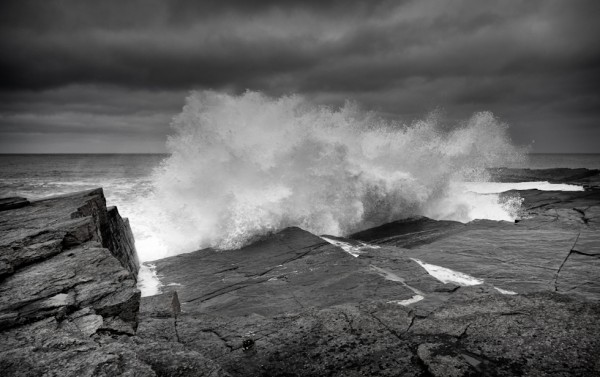Long exposure photography
Posted: July 10th, 2012 | Tags: Photography • Tutorials | Posted in: Photography, TutorialsYesterday I received my B+W 10 stop ND filter, which as you can guess, reduces the amount of light getting to the sensor by 10 stops, making it perfect for taking long exposure shots in pretty much any light! Handy!
The weather wasn’t terribly nice last night at Wick’s South Head, but that made for a nice big swell in the sea, and the white, frothy water being thrown up onto the flat sedimentary rock produced the following shot:

I took this shot at ISO 100 – f/8 for 30 seconds, the base exposure (metering the shot without the 10 stop filter attached) was 1/30th of a second.
Let me explain the procedure I used to take this in steps:
- Compose and focus shot on tripod, with shutter release cable attached.
- In manual mode set the correct exposure (without ND filter attached) and take note of the shutter speed.
- Recalculate shutter speed to give correct exposure with ND filter attached. More about this in a minute…
- Attach ND filter and set shutter speed from calculation above.
- Hit the shutter release… and wait
The only complicated thing is calculating the new shutter speed, but even that’s not too difficult.
Calculating long exposure times
If you like mathematics, the formula for calculating shutter speed with a neutral density filter is quite simple:
T(n) = t x 2 ^ n
n = Stop value of your ND filter (10 stops for my ND filter)
t = Base shutter speed (without filter attached) in seconds (1/30th of a second for my shot)
T(n) = Final exposure time
So, for the above shot we calculate:
- 2 ^ 10 = 1024
- Convert 1/30 second from a fraction to decimal: 1 / 30 = 0.03333333333333
- 0.03333333333333 * 1024 = 34.1333333333299
So, about 34 seconds (Yep, I slightly underexposed my shot).
Even better, get an app to calculate long exposure times for you!
If you’re not very keen on doing the above calculation every time you want to take a long exposure shot there are smartphone apps available to do it for you. The one I use on my iPhone is called LongTime Exposure Calculator, and it’s free!
There is also a free app for Android smartphones called Exposure Calculator, and although I’ve never used it, it looks like a good one.
And remember…
Just because long exposures of moving water and sky are cool, don’t forget that moving water and sky also look pretty cool when they are frozen with fast shutter speeds:


So, take both types of shot when the opportunity arises!